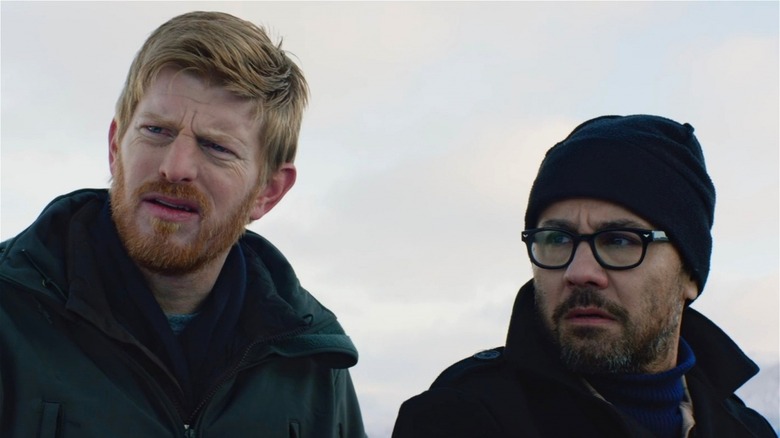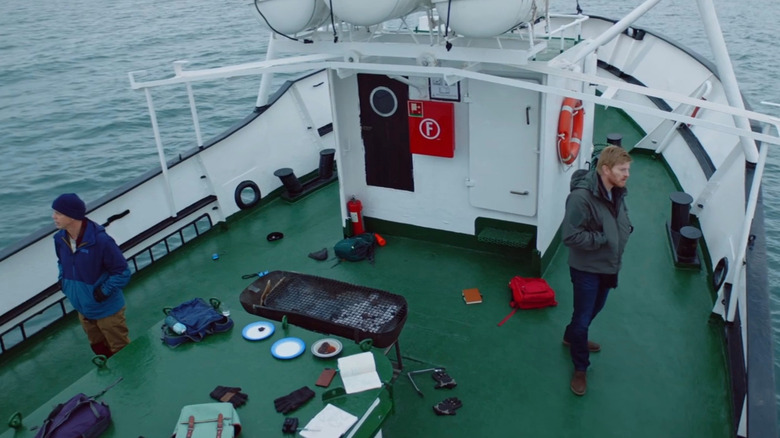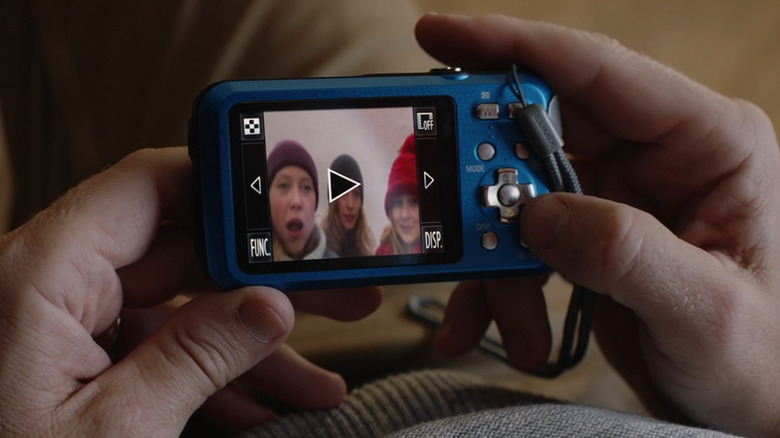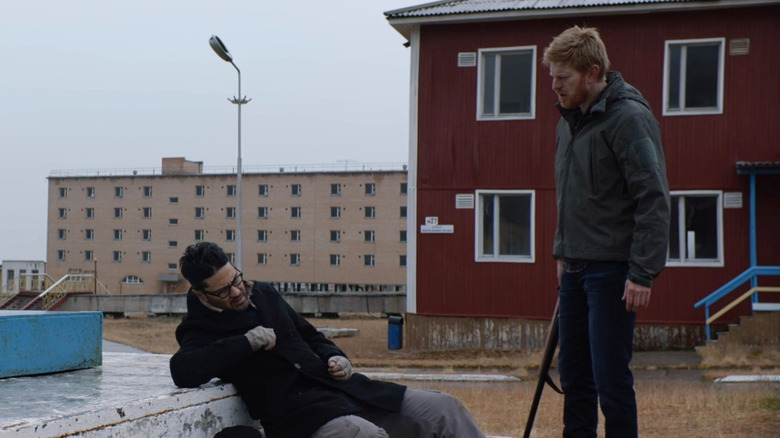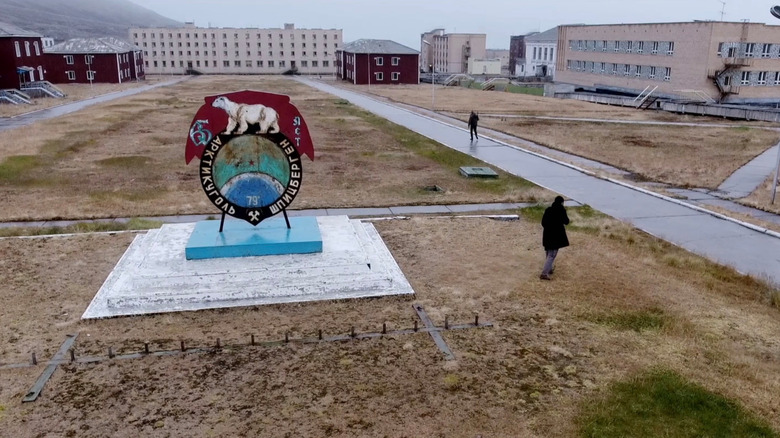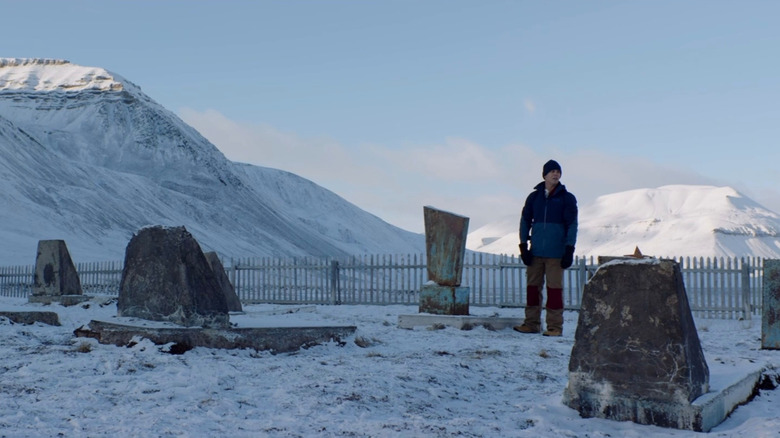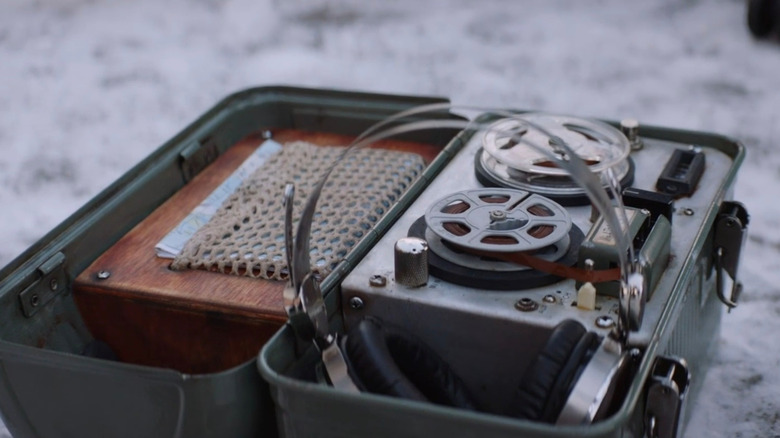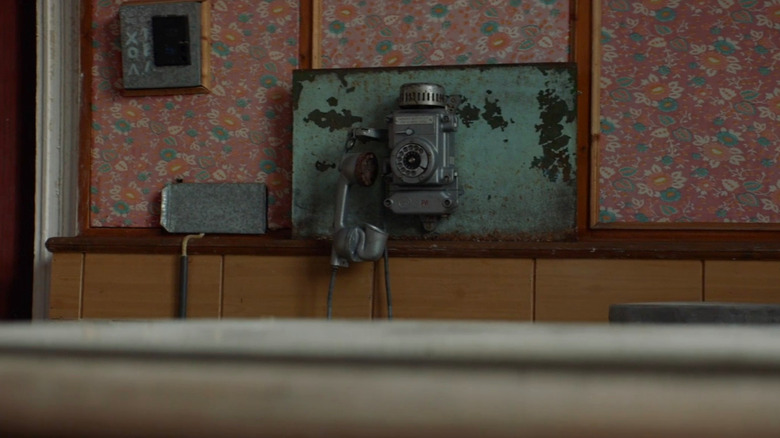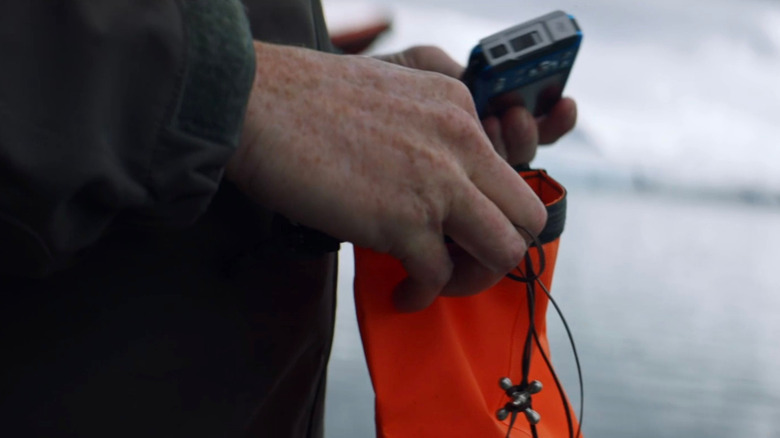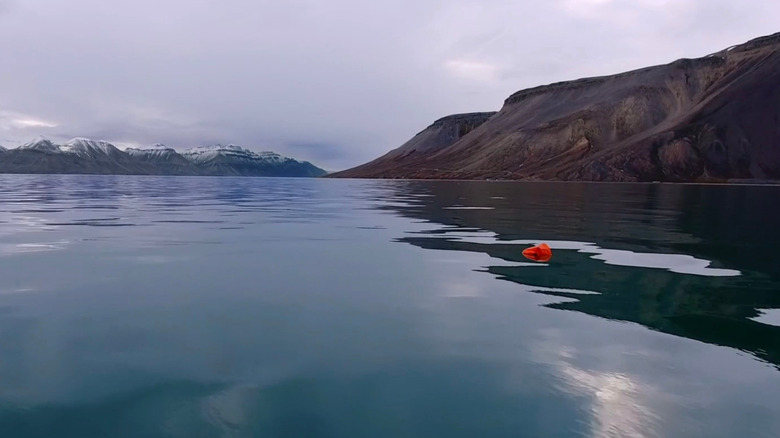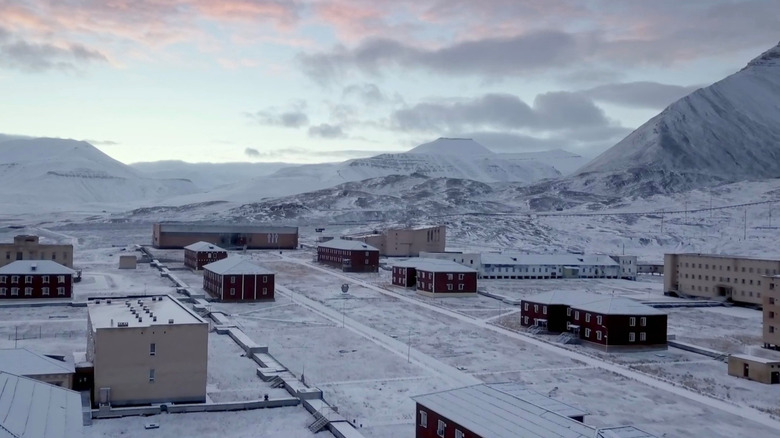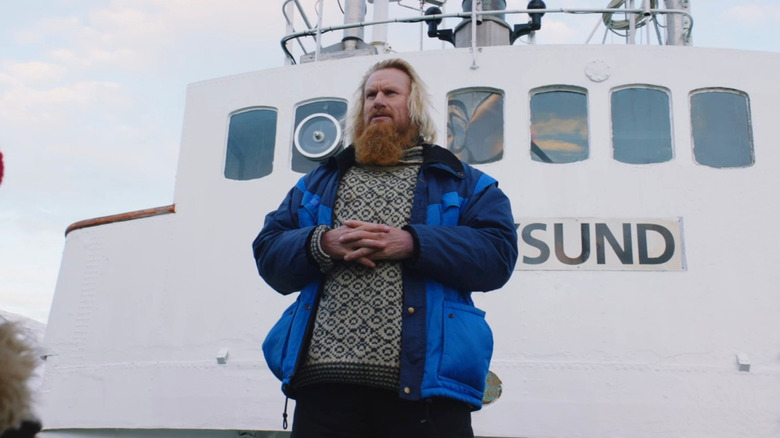The Ending Of Arctic Void Explained
"Arctic Void" follows the story of three men battling isolation, as well as more ominous unexplained elements, in the teeth-chattering Norwegian tundra. The men embark on this journey to film an episode for their nature TV series, boarding a boat to take in the beautiful blue waters, mountain-lined horizon, and native sea life. However, their documentation quickly devolves into disorientation when all the fellow passengers on board vanish into thin air.
The film escalates as the men struggle to explain this strange phenomenon. With no other options, they take a life raft to a nearby town they spotted along the shore, only to find this town is just as equally deserted. The sinister air of the film is magnified as the men encounter wildlife suffering strange sores and abrasions, which then begin appearing on one of the men. For hours, the men suffer physical and psychological torture, before the film's final reveal that this was all part of an elaborate experiment, and they were among the lab rats.
While "Arctic Void" is the definition of a low-budget, indie film, it does pack a much bigger punch than promised. It had a small-scale production, shot in only 16 days with 16 actors on location in Svalbard Norway, but the final cut is an impressively eerie masterpiece. It leaves audiences' minds spinning with endless possibilities, and unanswered questions. While some shadowy remains of this permafrost puzzle may never be fully resolved, there are some loose ends that can be tied up upon closer examination.
What you need to remember about Arctic Voic
The two protagonists of "Arctic Void" are Ray Marsh (Michael Weaver) and Alan Meursault (Tim Griffin), two childhood best friends turned Hollywood hit-makers. The film opens with the men arriving at a small airport, before making their way to a dock to greet Sean (Justin Huen), the local cameraman they hired as a last-minute replacement for the shoot. Once all on board the Langøysund, a chartered cruise ship, the men settle into their journey, chatting it up with fellow passengers and listening with perked ears as the local guide narrates their journey asea.
Uneasiness first takes hold when Ray spots a seagull bleeding from the eyes, and then the boat passes a seal lion mauling a younger pup, which the tour group remarks is extremely unusual. The men brush this disturbing sight off at first, but later realize there's real trouble in the waters when, out of nowhere, everyone else on board but them vanishes. Their belongings are still strewn along the deck, but there's not a soul in sight.
The men are left dumbfounded by this phenomenon, and to make matters worse, the power on the boat has mysteriously stopped working. With no way to send for help, the three men take a life raft to Svalbard, a town they spotted along the shore. Once there, they discover that Svalbard is just as void of human life as the Langøysund. As they make their way through desolate, abandoned buildings, they encounter wildlife with bleeding cuts and sores. Things take an even more sinister turn when Alan starts to fall ill, throwing up blood and displaying the same strange abrasions. The clock begins ticking for Alan, but the men only find themselves further and further from the reveals and rescue they seek.
What happened at the end of Arctic Void?
Towards the end of the film, Alan is reviewing some footage from a camera belonging to one of the vanished passengers when he makes a shocking discovery. In the footage, you can see the exact moment when the vanishing happens, and in the background, Sean can be seen standing on the deck. This is strange to Alan, because back on the boat, when he and Ray had realized the others were missing, they had alerted Sean. However, Sean had acted as if this were news to him, claiming he had been in the bathroom, and hadn't noticed anything unusual. If he had seen the whole thing happen, why did he act surprised?
After Alan shares his suspicions with Ray, Ray confronts Sean, tackling him to the ground and demanding answers. Sean confesses that the day's mysterious events are all part of an elaborate experiment by a secret organization. He was hired by this organization to film the effects of the experiment, but he wasn't fully in on the plan. He was told people would just experience some nausea and disorientation, not be totally vaporized, and he was also told he would be extracted from the boat. At this point, he's just as lost as Ray and Alan.
Though the men have understandable tension, they plan to get back on the raft and hopefully make their way to an inhabited town. However, Sean then gets a message from his secret satellite phone that the organization is coming to extract him. As the men wait to be saved, the film closes with Sean being shot in the head by an unseen sniper, leaving Ray and Alan alone with no promised salvation.
How does the experiment work?
When explaining the experiment to Ray during their confrontation, Sean confesses that the secret organization is using a powerful sonic weapon. This weapon emits a kind of vibration, or "hum" that can disrupt neural functioning in the brain. All of the strange sights they've witnessed, from the vanishing of their fellow passengers to the wounded and afflicted wildlife, have come as a result of being exposed to this sonic radiation.
Further insight into the inner workings of this experiment is foreshadowed earlier on in the film when Ray and Alan are talking with some fellow passengers who happen to be Norwegian scientists. They explain that this area is often plagued by geomagnetic storms which can affect the magnetic field and any technological devices in its radius.
Not only does this explain why the power on the boat shut off, but it also sheds light on the broader picture and implications of the experiment. Ray and Alan, as well as the other passengers, weren't specifically targeted by the organization because of who they were, but because of where they were. There's something about the area's unique magnetic field or vulnerability to disruption that facilitates the use of the sonic weapon. They only became lab rats because they decided to enter the maze.
Who was pulling the strings?
Not much is revealed in the film about who exactly is running the organization conducting the experiment, but it's almost definitely government-related. While Sean isn't a military operative or mercenary himself, he was an army brat growing up, and he says he was referred to the organization by a friend in the Navy.
As for which specific government is involved, it's likely the Russians. Norway shares a border with Russia along the Arctic, and in the film, Svalbard is shown to have significant Russian influence. This is demonstrated by the Cyrillic writing on buildings and public architecture throughout the town, as well as the Russian music which can be heard playing in the background at one point.
Svalbard is essentially a forgotten leftover locale of Soviet occupation, and given that it's a lowly inhabited, de-militarized zone, it's the perfect ground zero for some top-secret Soviet shenanigans.
Were supernatural elements involved?
Before the experiment is revealed, the film does carry a sense of certain supernatural forces at play. The fact that people literally vanished into thin air, as well as the bloody wildlife sightings, make it seem like there's an evil curse that's befallen the area. On top of this, Alan's ramblings throughout the film further reinforce the impression that the laws of nature may no longer apply to them.
At multiple points along their journey, Alan displays a lot of remorse and guilt, mostly in relation to leaving his family behind in favor of work. After realizing the town is abandoned, Alan remarks that they're in a ghost town, or perhaps they themselves are the ghosts, and at one point, he ominously states that this is always where they were meant to end up. Together, this gives the impression that the men are living out some sort of karmic punishment, or perhaps are in some sort of purgatory-like state.
Despite this early tone-setting for the film, it does not appear that supernatural forces were at play. This seems to have been a red-herring, distracting audiences so that the experiment reveal would be more of a shocking twist. In reality, the film is more science fiction than supernatural, and Alan was just speaking in paranoid riddles because his mind had been exposed to the hum.
Why didn't the men vanish along with the others?
One question audiences may ask themselves is how the three men on the boat managed to stay intact while every other passenger on the ship vanished. This seeming immunity to the experiment resulted from the lunchbox recorder that Sean had brought along for the trip.
When helping Sean bring his belongings aboard, Ray and Alan tried to carry the box for him, but Sean refused in a somewhat defensive manner. Curious about why the cameraman was being so cagey about this box, Ray and Alan had opened it to find a recording of sorts. The recording contained only strange, whale-like noises, so the two men hadn't paid much attention to it then, but this simple act turned out to be the two men's semi-saving grace.
During his confrontation with Ray, Sean explains that the recording emits a countering vibration that inoculates listeners to the sonic hum. By listening to this recording, Ray and Alan survived the vaporizing. However, since Alan listened to it for a shorter period than Ray, he wasn't totally immune, which is why he became increasingly ill throughout the film.
Do Ray and Alan survive?
While Sean is shot in the head at the end of the film and is almost certainly dead, Ray and Alan's ending is a bit more unclear. Alan is near death's door by the close of the film. He's covered in blood sores, he can barely speak or move, and he's drowning in his own blood. While Ray tries to persuade Alan to keep fighting, and even has him record a video for his kids to let them know he'll be home soon, Alan is pretty much resigned to his fate. The last shot we see of him shows him as unconscious and still, so it can be assumed that he unfortunately succumbs to the effects of the hum.
Whether or not Ray survives is more up to the audience's interpretation. Shortly after Sean is shot, the film cuts to Ray sitting next to a now unresponsive Alan. The phone on the wall next to the two men begins to ring over and over, but we never see whether or not Alan answers it. It can be assumed that it's the secret organization calling to check and see if the other two men are alive, and if they need to tie up any more loose ends apart from Sean.
If Alan answers the phone, he's almost certainly dead. The organization will find him, and kill him. However, if he lets it ring, perhaps they'll think he's dead and leave him alone. If he hides out for a while, he could eventually make his way back to the raft and on to safety. However, considering the power of this organization, the likelihood of a thorough post-op cleanup job seems high. In all likelihood, Ray doesn't make it, though it's not impossible.
Will the experiment ever be exposed?
If Ray does somehow survive long enough to get back to civilization, he will no doubt spread the news about this harrowing ordeal. As Alan tells Ray at the end of the film, this could be their best episode yet. Talk about killer ratings! While it's unlikely that Ray is going to get that opportunity, that doesn't mean their story will die with them.
The experiment could be exposed purely based on the fact that nearly 20 people went missing, and at some point, people are going to go looking for them. That's a strong possibility. However, there are actually a few key moments in the film that directly allude to the likelihood that news of the experiment will eventually come out via an alternate route.
After learning about the experiment from Sean, Ray goes to the shoreline with a task in mind. He takes the camera with the footage of the vanishing, as well as the phone that has the video Alan took for his kids, and puts it in a waterproof bag. He then seals the bag and tosses it into the water. Audiences can assume he does this in the event that he doesn't survive, with the hopes that someone will eventually find it and uncover the experiment. If you stick around until after the credits, there's actually another shot of the bag floating in the water.
Making this one of the last things audiences see gives the impression that the bag will eventually get found, but it's really up to interpretation.
Is there room for a sequel?
The ending of "Arctic Void" leaves plenty of leeway for another film, with multiple directions to take a sequel. An addition to the franchise could focus on Ray's efforts to elude the secret organization, escape Svalbard, and get justice for his fellow passengers. It could also leave behind the original cast altogether, and follow up on the promise of the floating bag, which holds the secrets that may eventually bring down the organization.
Another film could also take up the exact same storyline as the first. It could pick up right where "Arctic Void" left off, and continue to explore the sins of the secret organization. It'd be interesting to see whether they continue this experiment with a new batch of lab rats, expand it to include a larger radius of victims, or invent an entirely new technological weapon altogether. There has to be an endgame here, they're not designing this elaborate experiment for nothing. This weapon has a purpose. Is it just scientific curiosity? Is it world domination? Only a sequel holds the true answers.
Is Arctic Void based on a true story?
While it's semi-based in reality, the film is not based on a true story. It was written by Michael Weaver, the actor who plays Ray, and was based on story ideas by William Paul Jones, Jay Kirk, and Darren Mann. The specific characters and sequences of events are purely fictional. While it theoretically could happened, the secret organization would have to have done a pretty bang-up cover-up job, as there are currently no news stories about a group of 20 people vanishing into thin air on a boat in Norway.
Despite the exact details coming straight from the imagination, there are some historical events and conspiracies that follow a similar logic as the film. One example is the MK-ULTRA program, a secret CIA operation that took place in the 1950s and 1960s. Headed by chemist Sidney Gottlieb, the program's participants were subjected to intense psychological torture with the aim of proving and weaponizing mind control. While "Arctic Void" doesn't mention either the CIA or mind control, it does involve a secret government operation that affects the neural capacity of its targets, so there are some definite similarities there.
Another example is that the sonic vibration in the film is referred to as "The Hum," which happens to also be the name of a real-life phenomenon whereby people claim to hear a strange buzzing noise. Some claim it's a simple hearing problem, but others think it's an all-out government conspiracy. While there is no agreed-upon explanation for "The Hum," much less a consensus on whether this phenomenon is actually happening, the reports have been coming from all over the globe for decades, so there's definitely some substance to it.
What is the message of Arctic Void?
A mind-bending mystery with twists and turns, "Arctic Void" leaves audiences with a lot to think about. For most of the film, it appears as though the core message had something to do with respecting the sanctity of nature. When Ray and Alan are speaking with the tour guide on the boat, they ask him why anyone would live in such a harsh landscape. He jokingly retorts, "To get away from people like you." Here, he's making a comment about the men as Hollywood hotshots who like to come in with cameras and profit off of natural beauty, without providing anything in return. However, the guide then continues with a more serious answer: "It's the risk. Because here, nature has rules, and if you don't play by those rules, you're dead."
Despite this early symbolism-setting, the fact that it all turns out to be part of a carefully constructed scientific experiment actually turns this initial impression on its head. In reality, the film seems to be saying more about paranoia and control. In the end, the early signs that something wasn't quite right turn out to be correct, but it's not because the men weren't respecting nature, or weren't playing by its rules. In fact, they had very little to do with the experiment at all. They were just collateral damage — pawns in someone's else game. They knew something was off, but there was nothing they could do about it. The film plays on the audience's worst fears, that perhaps our fates aren't determined by whether we follow the rules, or how high our karmic credit is. Just because you make an effort to do the right thing, that doesn't mean bad things won't happen to you.
Maybe, just maybe, everything happens by chance, and we are completely resigned to our fate.
